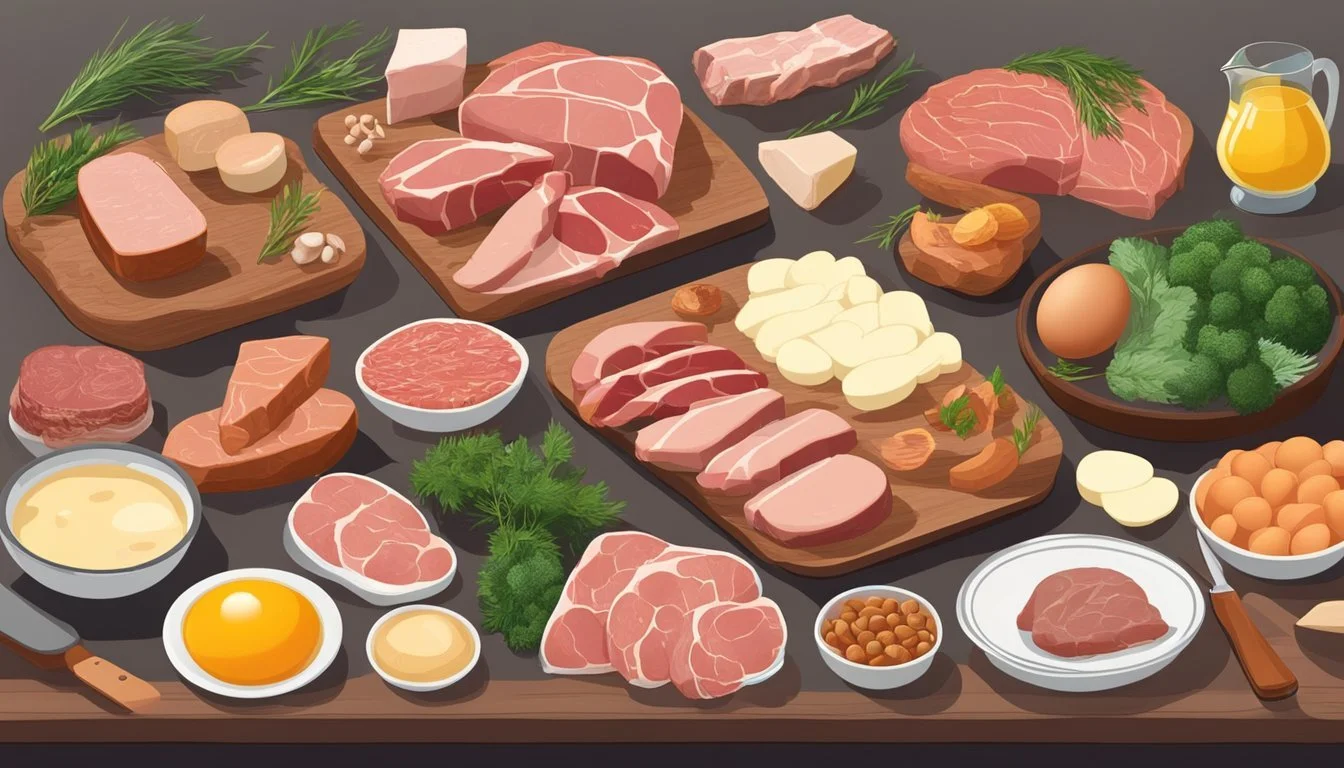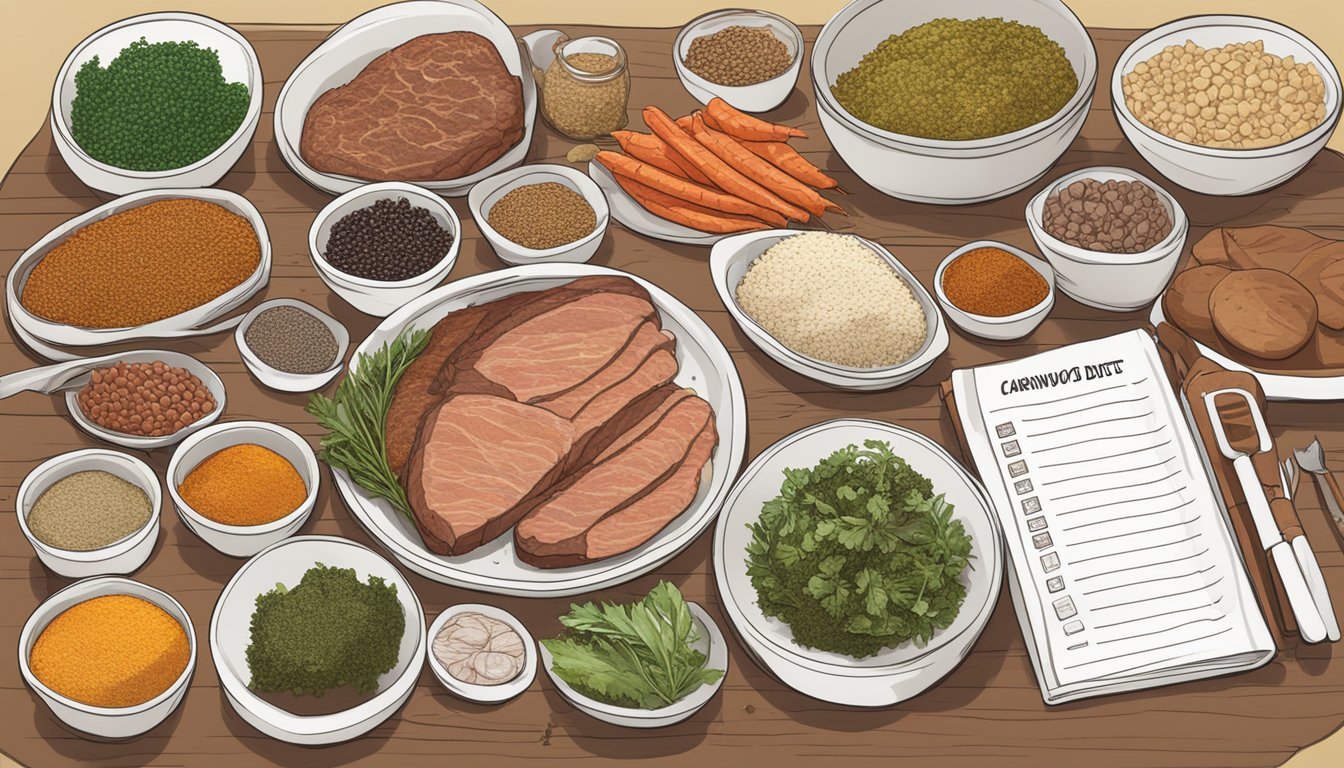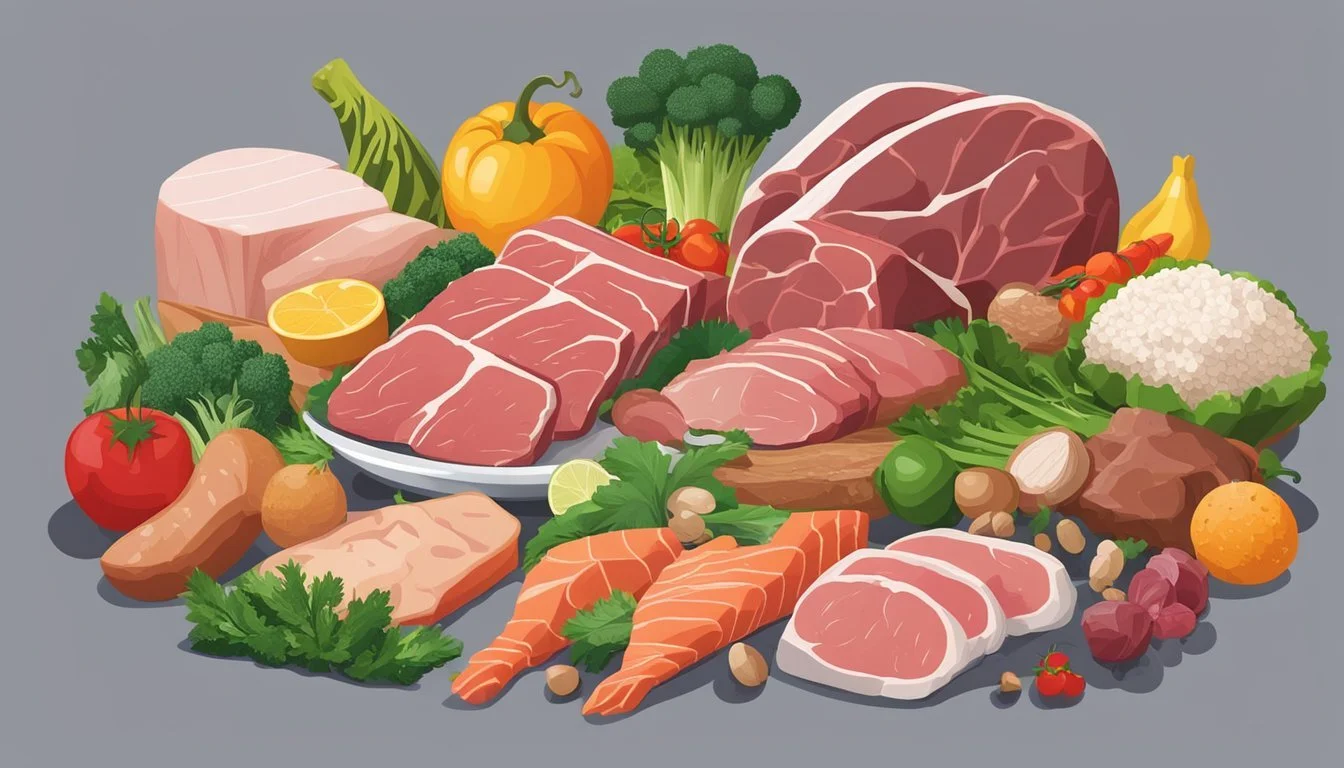How to Create a Carnivore Diet-Friendly Shopping List
Your Essential Guide
Embarking on a carnivore diet centers around the concept of consuming exclusively animal products. This dietary regimen eliminates plant-based foods and focuses on meats, fish, poultry, and full-fat dairy. A well-formulated shopping list is vital to ensure all dietary needs are met, avoiding the common pitfalls of limited variety and potential nutrient deficiencies. Such a list streamlines the process, supporting individuals to maintain adherence to the dietary approach with minimized effort and maximal nutritional benefit.
The carnivore diet, highlighted for its simplicity, hinges on selecting high-quality animal products. Meats, including muscle and organ types, are pivotal as they provide essential proteins, fats, and micronutrients. Fish and shellfish (What wine goes well with shellfish?) offer a rich source of Omega-3 fatty acids and other vital minerals. When it comes to dairy, choices are often tailored to individual tolerance, with a preference for full-fat options like butter and certain cheeses that align closely with the diet's macronutrient distribution. Understanding the nutritive value of each component helps one to build a comprehensive and effective shopping list.
Creating this shopping list requires a focus on food purity and nutrient density. Beyond choosing the appropriate animal products, it includes selecting cuts of meat that cover a wide range of nutrients, such as incorporating both muscle meat and organ meats like liver and heart. With a concise and informed list, individuals can navigate grocery stores efficiently, ensuring that their carnivore diet is both sustainable and nutritionally complete.
Understanding the Carnivore Diet
The Carnivore Diet is a dietary regimen that consists exclusively of animal products. Often referred to as a zero-carb diet, it eliminates all plant-based foods, thereby primarily sourcing energy and nutrients from meats and other animal products.
Proponents of the Carnivore Diet argue that it can lead to various health benefits, including weight loss and reduced inflammation. They posit that the diet's high protein and fat content can assist in achieving a state of ketosis, similar to what is aimed for in a ketogenic or keto diet. This metabolic state occurs when the body, lacking carbohydrates for energy, begins to burn fat instead.
Critics, however, caution that the diet's restrictive nature may lead to nutritional deficiencies, as plants are important sources of vitamins and minerals. Thus, it's vital for individuals to carefully select a variety of animal products to maximize nutrient intake.
Core Components of the Carnivore Diet:
Meat: Beef, chicken, pork, lamb, etc.
Seafood (What wine goes well with seafood?): Fish, shrimp, other shellfish.
Animal Products: Eggs, lard, bone marrow, butter.
As an elimination diet, the Carnivore Diet simplifies food choices, which may help in identifying food intolerances. Individuals with autoimmune conditions or digestive issues sometimes explore this diet to pinpoint triggers in their standard eating habits.
By focusing solely on animal products, individuals on the Carnivore Diet should plan their shopping lists meticulously to ensure they consume a variety of meats and animal products to maintain overall health.
It's essential for individuals considering this diet to consult with a healthcare provider to ensure their nutritional needs are met and to monitor their health throughout the diet.
Essential Carnivore Diet Food Categories
In constructing a carnivore diet-friendly shopping list, one must focus on nutrient-dense and high-quality animal products. These essential categories form the cornerstone of the diet, providing the main sources of protein, fat, and other essential nutrients.
Meats
On a carnivore diet, fresh meats are fundamental. The list should prioritize:
Beef: Including all cuts like steaks, roasts, and ground beef.
Chicken: Whole chickens or parts, such as thighs or breasts, with the skin on to retain fats.
Pork: Options like pork chops, (What wine goes well with pork chops?) ribs, and bacon (how long does bacon last?).
Seafood
Seafood is a great source of protein and omega-3 fatty acids. Include a variety of:
Fish: Fatty fishes like salmon should be a top choice for their high nutrient content.
Seafood: Other items could be shrimp, mussels, (What wine goes well with mussels?) and lobster.
Animal Fats
Pure animal fats are crucial for energy and cooking. Seek out:
Fat: Such as tallow or lard.
Bone Marrow: Which can also be consumed directly or used to enrich other dishes.
Dairy Products
Some dairy is permissible, but it should be high-fat and low-lactose:
Butter: High-fat and suitable for cooking.
Cheese: Hard cheeses are preferred as they are generally lower in lactose.
Eggs
Eggs are a versatile and complete protein:
They can be cooked in various ways and are excellent for any meal.
Bone Broth and Organ Meats
Rich in vitamins and minerals, these items should not be overlooked:
Bone Broth: Homemade is ideal to avoid additives and can be sipped or used in cooking.
Organ Meats: Liver, kidney, and heart provide dense nutrients and can be incorporated regularly.
I highly recommend purchasing tallow, lard, or ghee online for a convenient shopping experience!
Planning Your Meals
The success of adhering to a carnivore diet lies in meticulous meal planning and thorough preparation. By plotting out meals ahead of time, one ensures that their shopping list is comprehensive, covering all the necessary foodstuffs for daily dining.
Building a Meal Plan
In constructing a meal plan, one should look to incorporate a variety of meat-based protein sources for breakfast, lunch, and dinner (What wine goes well with dinner?) to maintain interest and ensure nutritional completeness. Snacks can consist of lighter meats or fish that are easy to consume on the go. It is advisable to list out each day's meals and rotate cuts of meat to provide diversity. A typical week may include steak options such as ribeye or porterhouse, versatile ground beef, bacon for a robust breakfast, loin or chops for satisfying lunch options, and poultry such as wings for a simple yet delicious dinner choice.
The inclusion of fatty fish such as sardines, mackerel, and trout introduces essential omega-3 acids. While planning, one should consider their personal preferences, budget, and the cooking time available to them.
Sample Meal Ideas
Below is a table of sample meal ideas that can be rotated throughout the week to suit individual preferences.
Weekly Meal Plan:
Monday
Breakfast: Bacon and eggs
Lunch: Ribeye steak (What wine goes well with ribeye steak?)
Dinner: Grilled trout
Tuesday
Breakfast: Ground beef patty
Lunch: Porterhouse steak
Dinner: Chicken wings
Wednesday
Breakfast: Pork loin chops
Lunch: Beef stew (What wine goes well with beef stew?)
Dinner: Broiled mackerel
Thursday
Breakfast: Steak and eggs
Lunch: Ground beef tacos (What wine goes well with beef tacos?)
Dinner: Sardine salad
Friday
Breakfast: Scrambled eggs with ham
Lunch: Bacon-wrapped filet
Dinner: Lamb chops (What wine goes well with lamb chops?)
Saturday
Breakfast: Sausages
Lunch: Cold cut platter
Dinner: Roasted chicken thighs (What wine goes well with chicken thighs?)
Sunday
Breakfast: Omelet with cheese
Lunch: Barbecue pork ribs (What wine goes well with pork ribs?)
Dinner: Grilled salmon (What wine goes well with grilled salmon?)
This table should serve as a guide and can be adjusted based on the individual's dietary needs and taste preferences. Having these meal ideas in place simplifies constructing a food list and ensures a structured approach to grocery shopping.
Creating a Carnivore Diet-Friendly Shopping List
When embarking on a carnivore diet, it is crucial to select a variety of animal-based products to maintain nutritional balance. A strategic approach to building a shopping list ensures that all necessary items are included, sorted by food type, and aligned with meal frequency requirements.
Listing Necessary Items
One's carnivore diet shopping list should encompass a wide range of meats, including beef, lamb, pork, poultry such as chicken and turkey, and game. It is important to include both muscle meats and organ meats like liver and heart, which are dense in nutrients. Fish, such as salmon, tuna, and mackerel, provide a good source of Omega-3 fatty acids. Essential animal-derived products like eggs and select dairy products—including hard cheeses and butter—should be part of the list, as should animal fats for cooking, such as tallow and lard.
Organizing by Food Type
To streamline the shopping experience, organize the items by food type. The following table offers an example layout for the carnivore diet food list:
Red Meat
Beef, lamb, pork
Poultry
Chicken, turkey
Organ Meat
Liver, heart
Fish
Salmon, tuna, mackerel
Dairy
Hard cheeses, butter
Eggs
Animal Fats
Tallow, lard
Seafood
Crab, sardines
Separating these items into categories helps individuals quickly locate each on their shopping list without overlooking crucial components of the diet.
Accounting for Meal Frequencies
Consider the frequency of meals when planning the quantity of each item. For those who eat three times a day, larger quantities of meats and eggs may be required. It’s also practical to account for quick meal options like canned fish or pre-cooked hard-boiled eggs. While frequent seasoning is not a staple of the carnivore diet, basic seasonings such as salt and pepper can be included for enhancing the flavor of the dishes. However, one should be cautious with spices and sauces as many contain non-animal ingredients or additives that may not align with the strict carnivore protocol.
If you're looking for salt and pepper, buying it online is your best bet!
Selecting Quality Meats and Seafood
When building a carnivore diet-friendly shopping list, selecting high-quality meats and seafood is crucial. This section will guide you through understanding meat labels and choosing sustainable seafood, ensuring that your carnivore diet is not only nourishing but also conscientious.
Understanding Meat Labels
When purchasing meat, especially beef, consumers are often confronted with a variety of labels such as grass-fed, organic, and grain-finished. Grass-fed beef, sourced from ruminant animals like cows and bison, implies that the animals were fed a natural diet of grass, which can affect the nutritional content of the meat. Studies suggest that grass-fed meat contains higher levels of omega-3 fatty acids and antioxidants.
Here is a simple breakdown of common labels:
Grass-fed: Indicates animals had a diet consisting of grass or forage.
Organic: Refers to meat from animals raised without synthetic hormones or genetically modified feed.
Grain-finished: Animals started on grass but switched to grains to increase marbling before slaughter.
Additionally, for poultry such as chicken, duck, and turkey, labels like free-range or pasture-raised can shed light on the living conditions and diet of the birds, which can influence the flavor and nutrition profile of the meat.
Choosing Sustainable Seafood
Sustainable seafood choices are as vital as the quality of meat in a carnivore diet. Fish like salmon and tuna and shellfish including shrimp, lobster, and oysters should be sourced thoughtfully to ensure the longevity of ocean ecosystems.
Here is a checklist for selecting sustainable seafood:
Opt for wild-caught where possible, as these fish are generally considered to have a better omega-3 profile compared to farm-raised counterparts.
Look for certifications such as the Marine Stewardship Council (MSC) label, which indicates sustainable fishing practices.
Ask about the origin of seafood to ensure it's not from overfished waters or farmed in a way that harms the environment.
Seafood, particularly types like oysters, are nutrient-rich and can add variety and essential micronutrients to a carnivore diet regimen. However, the overriding principle is to ensure that the choices made are not only good for health but also for the planet.
Including Fats and Seasonings
In a carnivore diet, it's crucial to select appropriate fats for energy and to use seasonings judiciously to enhance the flavor of meals without diverging from dietary guidelines.
Selecting Healthy Fats
On a carnivore diet, individuals should focus on fats that come directly from animal sources. These fats are considered healthy and are a pivotal aspect of the diet due to their high energy content and ability to provide satiety.
Butter: A saturated fat that's appropriate for cooking and adding richness to meats.
Ghee: Clarified butter, which is lactose-free and has a higher smoke point for cooking.
Tallow: Rendered fat from beef or mutton, excellent for high-heat cooking.
Lard: Fat from pork, suitable for cooking and baking.
Heavy Cream: Can be used in small amounts to add creaminess to coffee or sauces.
Understanding the Role of Seasonings
Seasonings should be minimal but can be used to enhance the flavor of meats. Keeping sodium levels sensible and choosing spices selectively is important.
Salt: Essential for electrolyte balance and improves taste. Favor unprocessed salts like sea salt or Himalayan salt.
Pepper: A simple spice that adds heat and dimension to meats.
Spices: If used, they must be pure and free from additives or sugars.
By incorporating these fats and seasonings thoughtfully, one can adhere to the carnivore diet's principles while enjoying flavorful meals.
Navigating Dairy and Eggs
When incorporating dairy and eggs into a carnivore diet, individuals must select options that align closely with the diet's principle of consuming animal products, while paying attention to personal tolerance and dietary goals.
Dairy Choices
Dairy products can offer variety on the carnivore diet. Butter and heavy cream are high-fat options that provide both flavor and fat-soluble vitamins. One should prioritize dairy with minimal additives. For cheese, the following are typically well-received:
Hard Cheese: (e.g., Cheddar, Gouda)
Soft Cheese: (e.g., Brie, Camembert)
Fermented Dairy: (optional, e.g., Yogurt, Kefir)
It's important to note that some individuals may have sensitivities to dairy, and as such, consumption should be based on personal response.
Egg Options
Eggs serve as a staple in the carnivore diet, offering a convenient source of complete protein and essential nutrients. They can be prepared in various ways:
Boiled eggs: Easy to prepare in batches for quick snacks or meal additions.
Omelettes or scrambled eggs: Versatile for incorporating other carnivore-friendly ingredients like cheese.
Shopping List Snapshot:
List of Dairy Products with Notes:
Butter
Preferably grass-fed
Opt for pure, additive-free
Hard Cheese
Limited ingredients, aged options
Soft Cheese
Include options like Brie
Yogurt
Unsweetened, natural fermentation
List of Egg Types with Preparation Suggestions:
Whole Eggs
Preparation Suggestion: Look for free-range or organic
Boiled Eggs
Preparation Suggestion: Easy to prepare ahead of time
In summary, shoppers should opt for full-fat, unprocessed dairy products and fresh eggs while being mindful of their body's dietary tolerances.
Incorporating Organ Meats
When creating a carnivore diet-friendly shopping list, one cannot overlook the nutritional powerhouse of organ meats. They hold an array of essential nutrients and can contribute to a well-rounded dietary intake.
Liver is arguably the most nutrient-dense of all organ meats, rich in vitamin A, B vitamins, iron, and choline. Individuals incorporating liver into their diet can aim for beef, chicken, or lamb liver, recognizing it as a staple for carnivore dieters.
Next, the heart is an excellent source of coenzyme Q10 and high-quality protein, vital for energy production and muscle health. Beef and chicken heart can be included and are often prepared grilled or in stews.
Kidney also offers important nutrients and a distinct flavor, adding variety to the diet. Rich in selenium and B vitamins, kidneys from various animals can be considered while planning meals.
Another valuable addition is bone marrow, which is a source of healthy fats, collagen, and nutrients that support immune system functions and joint health.
When shopping, consider the following table to organize your selection of organ meats:
Liver
Key Nutrients: Vitamin A, B Vitamins
Cooking Suggestions: Pan-fry, pate
Heart
Key Nutrients: Coenzyme Q10, Protein
Cooking Suggestions: Grill, stew
Kidney
Key Nutrients: Selenium, B Vitamins
Cooking Suggestions: Sauté, stews
Bone Marrow
Key Nutrients: Fats, Collagen
Cooking Suggestions: Roast, spread on toast
Inclusion frequency varies according to individual health goals, but aiming for 3–5 times a week allows for nutrient variety while preventing potential nutrient excesses. Those new to organ meats can start with smaller quantities to accustom their palates.
Hydration and Beverages
In adopting a carnivore diet, one's attention to hydration and suitable beverage choices is crucial. Water is fundamental, while options like unsweetened tea, black coffee, and bone broth align well with zero-carb dietary restrictions.
Prioritizing Water Intake
Water is the foundation of hydration on any diet, especially the carnivore diet. It is essential for maintaining bodily functions and facilitating digestion. Individuals following the carnivore diet should aim to consume at least 64 ounces of water daily, adjusting as needed for factors such as activity level and individual thirst.
How Much to Drink: At least 8 cups (64 ounces) a day
Adjusting Intake: Increase during high activity or as required
Considering Zero-Carb Beverages
While water should be the mainstay, those on the carnivore diet can enjoy other beverages that are carb-free and do not disrupt the diet's principles.
Black Coffee: A zero-carb option to start the day or for an energy boost.
Unsweetened Tea: Herbal varieties can be a good alternative for those seeking variety.
Homemade Bone Broth: Nutrient-rich, supports digestion, and aligns with the diet's emphasis on animal products.
Individuals should ensure teas and coffees are consumed plain, without sweeteners or milk, unless it's heavy cream or milk from an animal source. Bone broth can be homemade to ensure it is free from additives that are not part of the carnivore diet.
Managing Your Carnivore Diet Budget
Creating a shopping list for the carnivore diet while managing a budget requires a strategic approach. The goal is to prioritize high quality animal products while minimizing costs. This is accomplished through careful selection and purchase strategies.
They should focus on buying in bulk where feasible, taking advantage of discounts on large quantities. Shopping from local butchers or directly from farmers can often yield better prices, especially for those willing to purchase larger amounts at once.
On their shopping list, individuals should include a variety of cheaper cuts of meat which are often less in demand but equally nutritious. Organ meats, for instance, are usually less expensive and provide a dense nutrient profile.
Eggs and canned fish should also appear on a carnivore diet meal plan shopping list, as they can be cost-effective sources of animal-based nutrients. One must not forget to add bone-in meats, which tend to be cheaper and contribute to making nourishing bone broth.
Here's a simple list format to use for budget-conscious shopping:
Bulk Meat Purchases: Beef, pork, chicken, lamb (focus on less expensive cuts)
Organ Meats: Liver, heart, kidney
Seafood: Canned fish like sardines, mackerel, tuna
Eggs: Considered nature's multivitamin and usually economical
Bone-In Options: For broths and stews
To further manage their budget, one may track prices across different stores, perhaps via a spreadsheet, and note when certain items go on sale. In doing so, individuals can plan their purchases accordingly and even stock up when prices are most favorable.
Health Considerations and Nutritional Balance
When adopting a carnivore diet, individuals prioritize animal products for their high protein and fat content. However, one must ensure a balanced intake of nutrients, vitamins, and energy. In this diet, carbohydrates are minimal, so the body shifts to using fat and protein for energy, which can support weight management and may reduce some cardiovascular risk factors.
Nutritional Breakdown:
Proteins and Fats: They are the primary focus and are essential for building and repairing tissues and providing energy.
Vitamins: Certain vitamins are abundant in animal products. Vitamin A and vitamin D are notably high in organ meats and fatty fish.
Despite the potential benefits, one should consider the potential risks of insufficient fiber and certain vitamins usually derived from plant sources. A well-planned carnivore diet can counteract these risks:
List of Nutrient Sources in a Carnivore Diet and Their Role in the Body:
Vitamin A
Sources: Liver, fish oils
Role in Body: Supports vision, immune function, and organ health.
Vitamin D
Sources: Fatty fish, liver, egg yolks
Role in Body: Critical for bone health and immune function.
Other Nutrients:
Sources: Bone marrow, eggs, certain dairy products
Role in Body: Provide a range of B vitamins and minerals like zinc and iron.
To mitigate nutrient deficiency, they can include a variety of animal-based foods, such as:
Organ meats (for vitamins and minerals)
Fatty fish and fish oils (for vitamin D and omega-3 fatty acids)
Bone broth (for minerals)
Eggs and full-fat dairy with low lactose content (for additional vitamins and calcium)
It's recommended that they consult with a healthcare professional before starting a carnivore diet. Tailoring the diet to individual health needs ensures nutritional balance and supports overall well-being.
Navigating Eating Out and Social Occasions
When on a carnivore diet, individuals need to carefully select their meals and communicate their food preferences while dining out or engaging in social eating. This ensures they stick to their meal plan and enjoy their social life without dietary compromise.
Making Smart Choices at Restaurants
When selecting a restaurant, one should look for places that offer a variety of meat-based options, such as steakhouses or barbecue joints. They can then focus on simple, non-processed animal foods that align with their carnivore diet. It's prudent to scrutinize the menus online before visiting to identify suitable dishes. For instance:
Steak: Choose plain, grilled options without marinades.
Seafood: Opt for grilled or steamed fish and avoid breaded varieties.
Eggs and Dairy: Request omelets or cheese platters, ensuring that no plant-based fillers are used.
Communicating Dietary Preferences
One should not hesitate to express their dietary needs to the server or chef. A clear communication strategy includes:
Being Specific: Clearly stating what one can and cannot eat helps the staff to provide suitable meal options.
Asking Questions: Inquire about the preparation methods and ingredients to avoid accidental consumption of non-carnivore diet foods.
Offering Suggestions: If the menu lacks suitable choices, one might suggest simple modifications, like substituting sides with an extra portion of animal protein.
Evolution of the Carnivore Diet
The Carnivore Diet has its roots as a zero-carb diet, focusing exclusively on animal products. It evolved from a simplistic meat-only framework to a more inclusive regimen consisting of various animal-based foods. The diet's progression mirrors the pursuit of nutritional strategies that promote weight loss, muscle growth, and overall health.
Initially, proponents advocated for a strict meat intake. However, they recognized that incorporating a broader range of animal products, such as eggs, dairy, and seafood, could enhance the diet's nutritional profile without sacrificing its core principles. This shift has allowed individuals to maintain ketosis - a metabolic state conducive to fat burning and energy efficiency - while engaging in an elimination diet that could identify potential food intolerances.
They began to distinguish between different tiers of Carnivore Diet, with purists adhering to a regime of only meat and water, and others adopting a more lenient approach.
List of Carnivore Diet Variations with Included and Excluded Foods:
Strict Carnivore
Included Foods: Meat, still water
Excluded Foods: Plant-based foods, carbonated beverages
Standard Carnivore
Included Foods: Meat, eggs, certain dairy, fish
Excluded Foods: Fruits, vegetables, processed foods
Relaxed Carnivore
Included Foods: All animal products, select low-lactose dairy
Excluded Foods: High-carb dairy, processed meat products
The evolution of the Carnivore Diet underscores the community's willingness to adapt and individualize the approach to meet one's dietary goals and constraints. They carefully construct their eating plans to target specific health outcomes, often seeking increased energy levels, weight management, and digestive simplicity.
Concluding Thoughts on a Carnivore Shopping List
Crafting a shopping list for a carnivore diet requires focus and precision. It's important to include a variety of animal-based products to achieve nutritional balance and meet personal dietary goals, which often relate to weight loss or improved health markers. A well-planned list ensures adherence to the meal plan and facilitates efficient shopping.
Essentials to include:
Meats: Beef, pork, lamb, game meats
Poultry: Chicken, turkey, duck
Fish: Salmon, mackerel, sardines
Organs: Liver, heart, kidney
Dairy (if tolerated): Eggs, butter, certain hard cheeses
Supplements: Electrolytes, if needed
When considering variety, remember that rotating different types of meats and fish can provide a broader range of nutrients. A shopper should prioritize quality, opting for grass-fed meats and wild-caught fish when possible.
For those following the carnivore diet for weight loss, leaner cuts may be preferable, although the diet typically embraces high-fat consumption for energy. Aligning the shopping list with health and weight goals is essential, which may mean adjusting the types and quantities of food purchased.
Lastly, shoppers might find meal planning streamlines their diet adherence. By knowing exactly what to buy, they avoid the temptation of non-compliant foods. For the best results, plan meals in advance, list necessary ingredients, and stick to the blueprint while at the store.


















